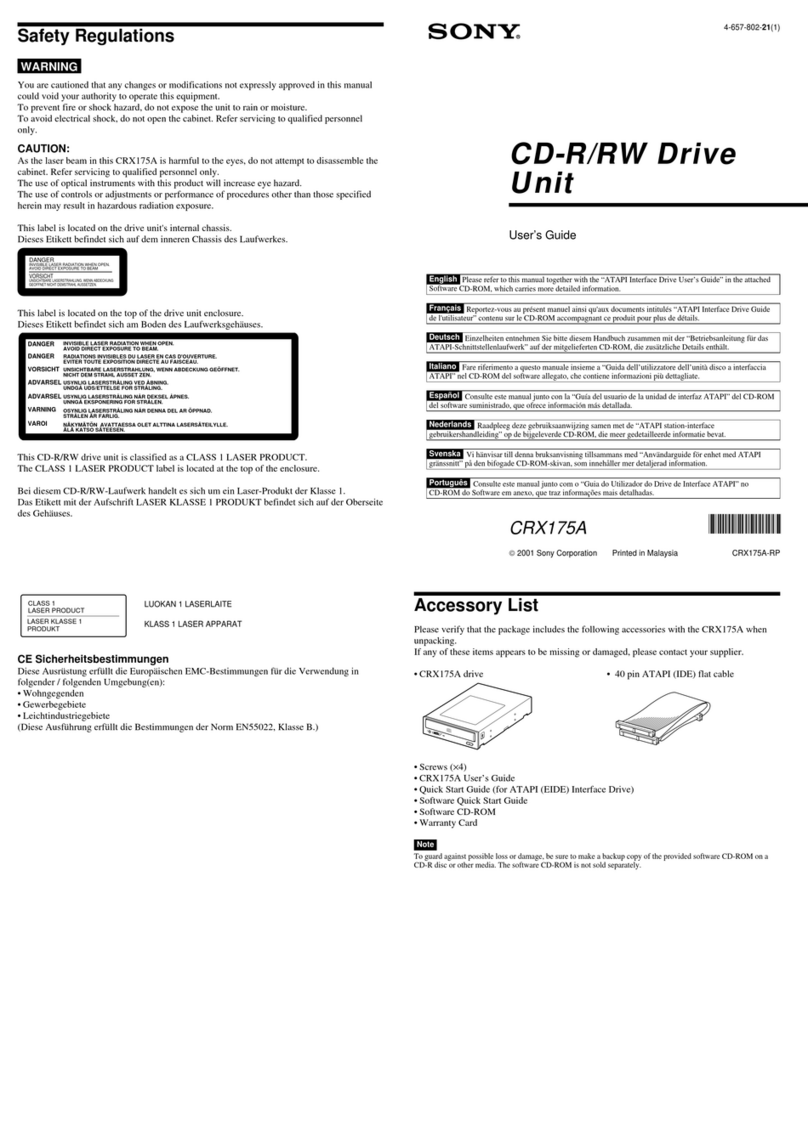
0---.-0
CDU-541
CD-ROM
DRIVE
SCSI
INTERFACE
MANUAL
TABLE
OF
CONTEN"l'S
1.
Preface
........................................................................................
1-1
2•
In
troduc
tion
..................•....................•..•.•••....••.....
2-1
3.
Physical
Characteristics
•••..............••.........•..•
'0'
••••••••••••
3-1
4.
Logical
Characteris
tics
..............................................•
4-1
4.1.
Conditions
.......................................................
4-1
4 . 1 .
1.
Power-on
Condi
tion
........................................
4-1
4 . 1
.2.
Reset
Condi
tion
•.....•........•..•..•.••...•..••••••.•.•.•
4-1
4.1.
3.
Unit
Attention
Condition
.•.......•.•.....••.••..•••.••••••
4-1
4.1.4.
Ready
Condition/Not
Ready
Condition
•••..••••••.•.••..••.••
4-2
4.1.5.
ATTENTION
Condition
..••.•.•..••••.•...••••••••.•.•••.••.•
4-3
4.2.
CODlDl8l'ld
Descriptor
Block
...........................................
4-4
4.2.1.
Operation
Code
.................................................
4-4
4.2.2.
Relative
Address
Bit
.....•................................
4-4
4.2.3.
Starting
Logical
Address
.••••••••••.••••••••••••••••••••••
4-4
4.2.4.
Transfer
Length
......................................................
4-4
4
..
2.5.
Parameter Length
.....................................................
4-4
4.2.6.
Allocation
Length
•..•••..•.•..•••.......••••....••••.••.••
4-4
4.2.7.
Flag
and
Link
Bits
•.•..•..•...••..•....•••••.•.•.••.•••.••
4-5
4.3.
Command
Processing
..••..••••...•.•....•....•..••••.••...•••.••.••
4-5
4.4.
Handling
of
Message
Phase
..•.•...••..••••......•••••.••••.•••.•.•
4-6
4•4.
1.
MESSAGE
IN
Phqe................................
...................
4-6
4.4.2.
MESSAGE
OtJT
Phase
.•.••.••••.•.•.••.••.••••••••••••••..•.••
4-6
4.4.3.
Messages
...................
I : I
••
ol;
~
, "
••
;.
.;
;.
~
•••••••••••••••
• 4-7
4.5.
Handling
of
Status
Phase
••••••..•..•..••.....••••••.••••••••••••
4-10
4.5.1.
Status
Byte
Description
.•.••••••.••••••••••••••••••.•••••
4-10
4.6.
Disconnect/Reconnect
............................................
4-11
4.1.
Disc
Compatibility
..............................................
4-11
4.8.
TOC
Recovery
Strategy
...........................................
4-11
4.9.
Audio
Playback
Implementation
Rules
••.••.•••••••...••..•••••••••
4-12
5.
CD-ROM
Devices
.......................................•.......•.•......
5-1
5.1.
CD-ROM
Model
.....................................................
5-1
5.2.
CD-ROM
Command
Descriptions
•.•.•.•....•....••••.•.••.•.•.••.•.••.
5-4
5.2.1.
INQUIRY
Command
•••.........................•.•....•...••.•
5-5
5.2.2.
MODE
SELECT
Command
•.....•...•..........•........•...••..•
5-8
5.2.3.
MODE
SENSE
Command
••....••..............•.........•••....
5-11
5.2.3.1.
Current
Values
.•.......•......•.•••••.•••••.•..•
5-11
5.2.3.2.
Changeable
Values
•..........•..•••.•..•.•••..•..
5-11
5.2.3.3.
Default
Values
.......•.•..........••.•.••..•.•..
5-12
5.2.4.
PAUSE
Command
.....•.•...........•..........•.•••.••...••.
5-14
5.2.5.
PAUSE/RESUME
Command
.....................................
5-15
5.2.6.
PLAY
AUDIO
Command
•.•.••.......••.........•••.•.••......•
5-16
5.2.7.
PLAY
AUDIO(10)
Command
•..•••....••...••.•••••••...•..•••.
5-17
5.2.8.
PLAY
AUDIO
MSF
Command
...................................
5-18
5.2.9.
PLAY
AUDIO
TRACK/INDEX
Command
••..•.....•.••..••••••.•••.
5-19
5.2.10.
PLAY
MSF
ComJland
.....•...••...••........•.••..•••••....•
5-21
5.2.11.
PLAY
TRACK
Command
.•••.••••....••...•..••.••.••••.•••..•
5-22
5.2.12.
PLAYBACK
CONTROL
Command
•.....•....•.•....•..........••.
5-23
5.2.13.
PLAYBACK
STATUS
Command
•••••..•..•.••...•••••.••••.•••••
5-25
5.2.14.
PREVENT/ALLOW
MEDIUM
REMOVAL
Command
....•.••.•..•••.••••
5-28
5.2.
15.
REA.D
Com.m8Ild
•••••••••••••••••••••••••••••
4o
••••••••••••••
5~29
Revision
1.00
-20
MAR
'89
Page 4



















































